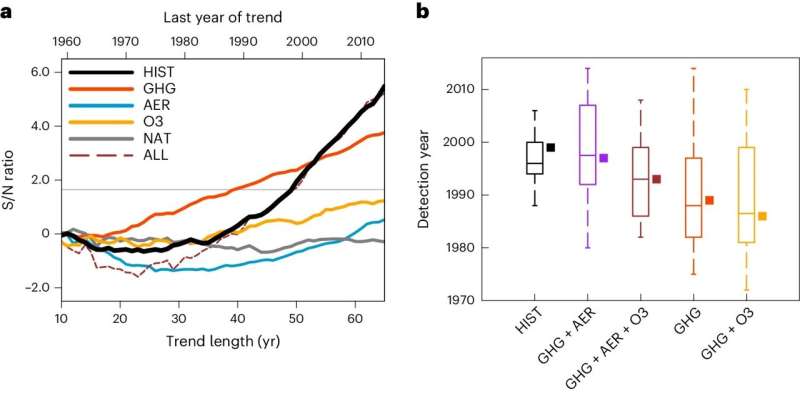This article has been reviewed according to Science X's editorial process and policies. Editors have highlighted the following attributes while ensuring the content's credibility:
fact-checked
trusted source
proofread
Sea surface temperature research provides clear evidence of human-caused climate change

New oceanic research provides clear evidence of a human "fingerprint" on climate change and shows that specific signals from human activities have altered the seasonal cycle amplitude of sea surface temperatures (SST).
"This is breakthrough evidence that there is a human-caused climate change signal in ocean temperatures associated with CO2 increases," according to co-author Benjamin Santer, an adjunct scientist and distinguished scholar in the Physical Oceanography Department at Woods Hole Oceanographic Institute (WHOI).
"We show that a human-caused signal in the seasonal cycle of sea surface temperature (SST) has emerged from the noise of natural variability. Geographical patterns of changes in SST seasonal cycle amplitude (SSTAC) reveal two distinctive features: an increase at Northern Hemisphere mid-latitudes related to mixed-layer depth changes and a robust dipole pattern between 40˚S and 55˚S which is mainly driven by surface wind changes," according to the journal published in Nature Climate Change.
"The evidence we found is very clear. Our research is based on four different observational data sets of sea surface ocean temperature. We analyzed data from various monitoring systems, including satellite records and ocean measurements that WHOI has been collecting from ships and floats since 1950."
"All of this data provided the same story and the same conclusion: that the human-caused signal in SSTAC is very strong and has a very distinctive pattern," reported co-lead author Dr. Jia-Rui Shi, Postdoc with WHOI.
The model-predicted pattern of SSTAC change is identifiable with high statistical confidence in four different observed SST products and in 51 individual model realizations of historical climate evolution. Simulations with historical changes in individual forcing reveal that greenhouse gas increases are the primary driver of changes in SSTAC, with smaller but distinct contributions from anthropogenic aerosol and ozone forcing.
The research was motivated by earlier work by Santer, who has worked on climate fingerprinting for more than 30 years. Previous studies used satellite records to identify human fingerprints in the changing seasonal cycle of mid-to-upper tropospheric temperature. However, this is the first fingerprinting study that reveals detailed patterns of climate change in seasonal sea surface temperatures.
"The seasonal cycle amplitude of sea surface temperature is changing and becoming stronger. One of our biggest findings is that warming is greater in the summer than in the winter. In both the northern and southern hemispheres, the mixed-layer depths of the ocean are becoming thinner, which can significantly amplify summer temperatures," stated Shi.
"The warming in the northern hemisphere is more extreme, associated with smaller ocean basin sizes. In the southern hemisphere, we discovered that sea surface temperature changes are largely driven by wind shift patterns caused by atmospheric warming."
"This research rebuts claims that recent temperature changes are natural, whether due to the sun or due to internal cycles in the climate system. A natural explanation is virtually impossible in terms of what we are looking at here: changes in the seasonal temperatures of the ocean," stated Santer. "This research further rules out the claim that we don't need to treat climate change seriously because it is natural."
"This robust human fingerprint in the seasonal cycle of ocean surface temperature is expected to have wide-ranging impacts on marine ecosystems. This can dramatically influence fisheries and the distribution of nutrients," said Shi. "Gaining insight into the anthropogenic influence on seasonality is of scientific, economic, and societal importance."
In 2023, the upper ocean heat content was the highest on record, leading to strong concern in the scientific community. The ocean absorbs roughly 90% of the Earth's excess heat from global warming and plays a vital role in regulating planetary climate systems.
"Ocean temperatures are literally off the charts. A lot of people want to know what is happening," said Santer. "A big part of the answer is that human activities have gradually warmed the world's oceans. The scientific community has been focused on changes in the ocean's annual average temperature. This paper shows that it's also critically important to perform fingerprinting with seasonal changes," said Santer.
The ocean is a vital carbon sink, absorbing 25% of the carbon dioxide that we produce by burning fossil fuels. However, the ability of the ocean to absorb CO2 is temperature-dependent. As the ocean warms, it is critical that we understand how the ability of the oceans to absorb CO2 is affected.
"As oceans absorb carbon dioxide, it creates widely reported acidification, which can negatively impact marine organisms. If we start altering the pH of the ocean, we risk affecting the structural integrity of organisms at the base of the food chain," said Shi.
"We now face important decisions, in the United States and globally, on what to do about climate change. Those decisions be based on our best scientific understanding of the reality and seriousness of human effects on average climate and on the seasons," stated Santer.
More information: Jia-Rui Shi et al, The emerging human influence on the seasonal cycle of sea surface temperature, Nature Climate Change (2024). DOI: 10.1038/s41558-024-01958-8
Provided by Woods Hole Oceanographic Institution




















